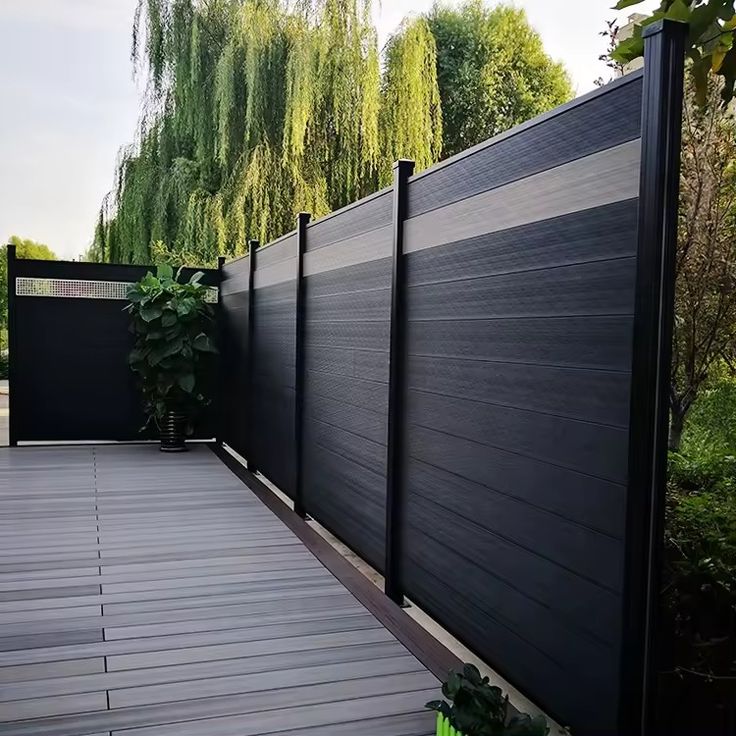Installing a fence on a sloped or uneven landscape presents unique challenges, but also exciting opportunities for creative design. Traditional fencing materials can be difficult to adapt to varying ground levels, often resulting in unsightly gaps or awkward transitions. Wood-Plastic Composite (WPC) fencing, with its modular nature and versatility, offers excellent solutions for navigating sloped landscapes, allowing homeowners to create a beautiful, secure, and seamless boundary that enhances their property’s unique contours.
This article explores various wpc fence ideas specifically designed for sloped landscapes, helping you transform challenging terrain into a visually appealing and highly functional outdoor space.
1. Stepped WPC Fencing: The Most Common and Effective Solution
The most popular and visually clean method for installing a fence on a slope is the “stepped” approach. This involves installing fence panels in horizontal sections, with each subsequent panel stepping down (or up) to follow the gradient of the land.
-
Aesthetic: Creates a clean, architectural look with distinct horizontal lines that complement modern and contemporary homes. The uniform panel sizes maintain consistency, while the stepping adds visual interest and adapts gracefully to the slope.
- Functionality: Ensures that the fence panels remain plumb and level, providing consistent privacy and security. The stepping allows for easy adaptation to various degrees of slope without needing custom-cut panels for every section.
- Installation: WPC’s modular panel systems are well-suited for stepping. Posts are set at varying heights, and panels are installed horizontally between them, creating a series of “steps” along the slope.
- Considerations: While effective, stepping can create triangular gaps underneath the fence panels where they meet the ground on a steeper slope. These gaps can be filled with gravel, small retaining walls, or landscaping to prevent pets from escaping or weeds from growing.
2. Raked WPC Fencing: Following the Contour
For a more continuous and flowing look that directly follows the natural gradient of the slope, “raked” fencing involves cutting each fence panel to match the angle of the ground.
- Aesthetic: Creates a smooth, continuous line that mirrors the natural slope of the landscape. This can be particularly appealing in more naturalistic garden designs or where a seamless flow is desired.
- Functionality: Eliminates gaps underneath the fence panels, offering maximum containment for pets and preventing debris from passing through.
- Installation: This method requires more precise cutting of each WPC panel or slat to match the angle of the slope. While WPC is easy to cut, this can be more labour-intensive than stepping and may require more advanced DIY skills or professional installation.
- Considerations: Ensure the WPC material is suitable for angled cuts, and that the cut edges are properly finished to maintain durability and appearance.
3. Terraced Landscapes with Integrated WPC Fencing
For steeper slopes, integrating the WPC fence with a terraced landscaping design can create a highly functional and aesthetically stunning multi-level outdoor space.
- Aesthetic: Transforms a challenging slope into usable, layered garden areas. The WPC fence can be installed on top of each retaining wall or terrace, creating distinct zones and adding vertical interest.
- Functionality: Retaining walls manage soil erosion and create flat, usable areas. The WPC fence then provides privacy and security for each terrace.
- Inspiration: Imagine a series of WPC fences installed on top of low gabion walls or timber retaining walls, creating tiered garden beds with integrated lighting, leading up a sloped backyard. This offers both privacy and a beautiful visual journey.
4. Mixed Materials for Sloped Transitions
Combining WPC with other materials can provide robust and visually appealing solutions for complex slopes.
- WPC with Stone or Concrete Bases: For the lowest section of a fence on a steep slope, a solid stone or concrete base can effectively manage the ground level, with WPC panels installed on top. This provides a strong, durable foundation.
- WPC with Retaining Wall Integration: WPC fence panels can be directly integrated into the design of a larger retaining wall, providing a seamless transition from hardscaping to fencing.
5. Strategic Gate Placement on Slopes
Gate placement on a slope requires careful planning to ensure functionality and safety.
- Level Gateways: It’s often best to create a small, level landing area for gates on a slope, even if the fence steps up or down around it. This ensures the gate swings freely and latches securely.
- Custom Gates: For very steep slopes, custom-fabricated gates that follow the rake of the land might be necessary, though these will be more costly.
By carefully considering the slope of your land and choosing the appropriate WPC fence design strategy, you can create a beautiful, durable, and functional boundary that perfectly complements your New Zealand outdoor space.

